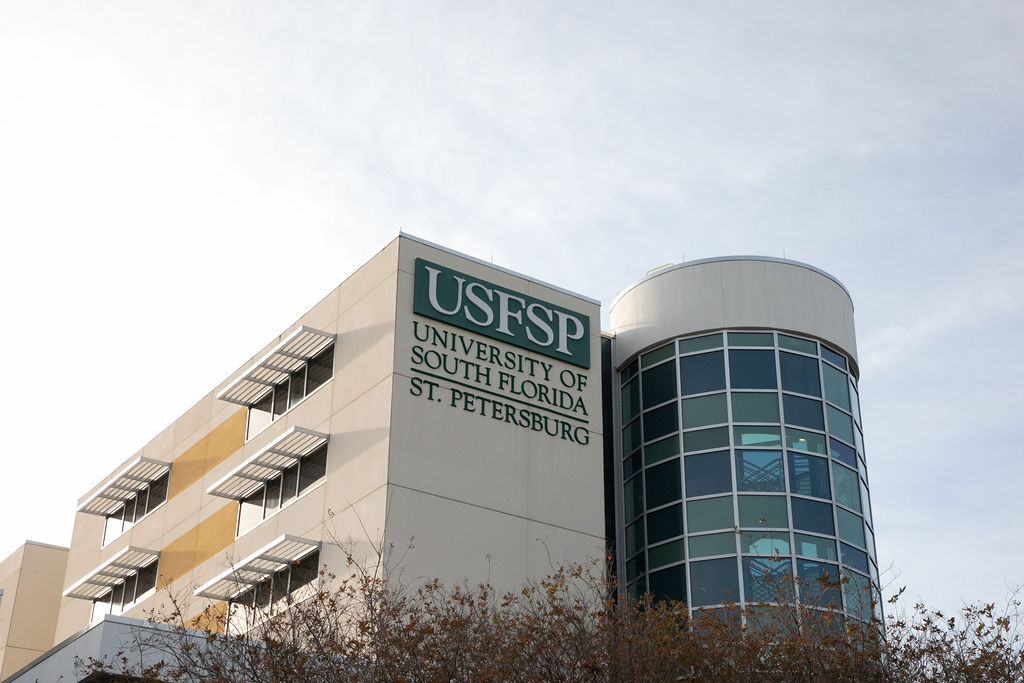Enrollment for Black undergraduate students saw the largest decline in the past five years.
Courtesy of Tara Zimmerman | The Crow’s Nest
By Aubrey Carr
Preliminary fall 2022 enrollment data for the University of South Florida St. Petersburg campus shows meager results in the strive for increased diversity amongst undergraduates.
A majority of undergraduate minority groups saw a drop in enrollment over the past five years, with the campus’ Black student population faring the worst –– a 6% drop from fall 2017 to 2022, declining from 353 students to 191.
In fall 2022, Black students made up just 6% of the campus’ population.
“Building a diverse student population is a journey, not a destination,” Christian Hardigree, regional chancellor of USF St. Petersburg, told The Crow’s Nest.
“We must be constantly focused on creating opportunities and access for a broad array of students, as well as bolstering the support mechanisms needed to help them succeed once they are here. While we continue to make progress, I’m not satisfied with where we are in that journey and remain committed to working with our partners throughout USF to ensure our student enrollment better reflects the diversity of our region,” she said.
Nilah Neely, marketing chair of the campus’ Black Student Association, believes the dwindling Black enrollment numbers are reason for concern.
“[The campus] can be somewhat welcoming for Black students, mostly because of student organizations, but most of the time, [it is] not,” Neely said.
“We’re such an extreme minority on campus in terms of ratio and numbers, it is completely isolating [and] people see that, so why would anyone want to come here?”
According to Neely, the university uses the idea of diversity to draw in racial minority students, without doing the work to provide adequate inclusion.
“If they actually had the diversity they spoke of, we’d have more Black people, specifically in this case, on [our] campus,” Neely said.
“I’m sure admissions would say we have less Black people here because we have smaller enrollment overall, but I guarantee you, the ratio of Black students isn’t growing,” she said.
As Neely believed, the percentage of Black students within the total student population has declined by 2% in the last five years.
“How are you going to advertise diversity when our numbers are getting smaller?” Neely said.
From 2017 to 2021, USF St. Petersburg published two informational pamphlets advertising the university’s priorities and accomplishments regarding diversity.
“We work to dismantle structures that perpetuate racism while actively promoting racial equity for our faculty, students, staff and community partners,” former USF St. Petersburg Regional Chancellor Martin Tadlock said in the 2019-2021 pamphlet.
While the pamphlets did report on the university’s various efforts to improve diversity and acceptance on the campus, the amount of racial and ethnic minorities within the community were not included in either edition.
According to Carrie O’Brion, director of communications and marketing for St. Petersburg, the University has developed a variety of programs to help increase the enrollment of underrepresented communities.
One of these programs being Pinellas Access to Higher Education (PATHe), a partnership between USF St. Petersburg and St. Petersburg College to help increase rates of higher education within the community.
“Our PATHe counselors have been doing some interesting and innovative work to help students and families throughout Pinellas County navigate the complexities of higher education. They held their first Fries and FAFSA event earlier this year and hosted nearly 50 students this summer in partnership with the Pinellas Urban League for an immersive college experience called Discover Your PATHe,” O’Brion said.
Additionally, in 2020, USF expanded its Guaranteed Admission Pathway Program to include various high schools within the county.
“The program guarantees admission to any of the USF campuses for qualified students who attend high schools serving historically underrepresented communities,” O’Brion said.
In addition to the Black student population, Hispanic students saw a 5% decrease, dropping from 716 to 658 students. American Indian students saw a 54% decrease, falling from 11 to five students. Students of two or more races saw a 13% decrease, going from 178 to 154 students.
In contrast, both Asian and Non-Resident Alien student populations saw growth. Asian student enrollment saw a 17% increase, going from 131 to 164 students and Non-Resident Alien enrollment saw a 121% increase, going from 28 to 62 students.
The population of undergraduate Native Hawaiian and Pacific Islanders stayed relatively stable, going from seven students to six.
Victoria Lim, president of St. Petersburg Asian and Pacific Islander Association, feels satisfied with the number of Asian students enrolled.
“I do feel that USF St. Petersburg has a diverse number of Asian students. I’ve met students of various ethnicities and [we have] had both east, south and southeast Asian members,” Lim said.
“[The campus] offers a lot of support for minority students, whether you’re Asian, African American or Hispanic. There are a lot of great events that happen on campus that revolves around ethnicity or cultures, and a lot of members try and promote cultural activities. There’s a lot of outreach for students, and we have a decent number of participants every year.”
Undergraduate diversity wasn’t the only number that saw a decline. Total undergraduate enrollment for fall 2022 has dropped by nearly 1,000 students since 2017’s preliminary figures, five years ago.




One thought on “USFSP Fall 2022 enrollment numbers show unimpressive results for student diversity”